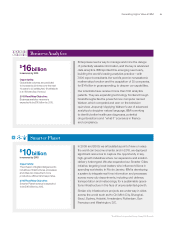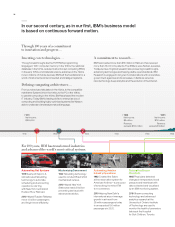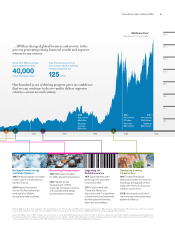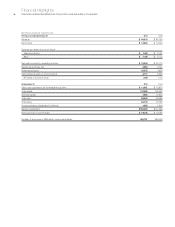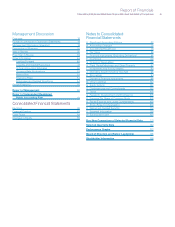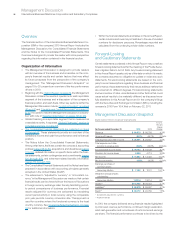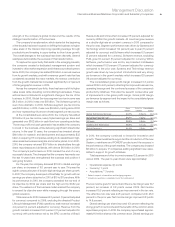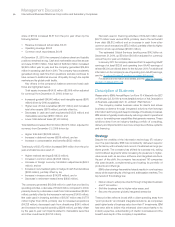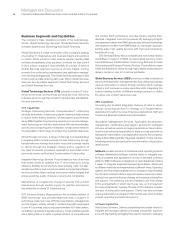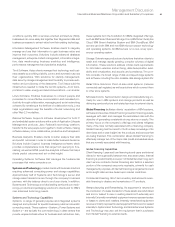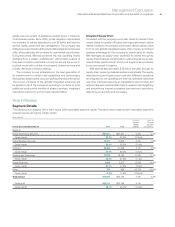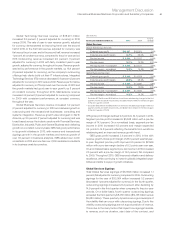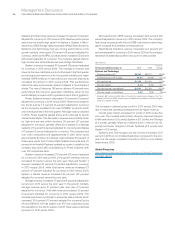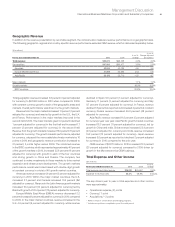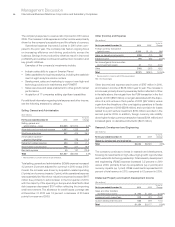IBM 2010 Annual Report Download - page 24
Download and view the complete annual report
Please find page 24 of the 2010 IBM annual report below. You can navigate through the pages in the report by either clicking on the pages listed below, or by using the keyword search tool below to find specific information within the annual report.22
Management Discussion
International Business Machines Corporation and Subsidiary Companies
Business Segments and Capabilities
The company’s major operations consists of five business seg-
ments: Global Tech nology Services, Global Business Services,
Soft ware, Systems and Technology and Global Finan cing.
Global Services is a critical component of the company’s strategy
of providing IT infrastructure and business insight and solutions
to clients. While solutions often include industry-leading IBM
software and systems, other suppliers’ products are also used if
a client solution requires it. Approximately 60 percent of external
Global Services segment revenue is annuity-based, coming
primarily from outsourcing, maintenance and application manage-
ment services arrangements. The Global Services backlog provides
a solid revenue base entering each year. Within Global Services,
there are two reportable segments: Global Tech nology Services
and Global Business Services.
Global Technology Services (GTS) primarily provides IT infra-
structure services and business process services, delivering
business value through the company’s global scale, standardiza-
tion and automation.
GTS Capabilities
Strategic Outsourcing Services. Comprehensive IT outsourcing
services dedicated to transforming clients’ existing infrastructures
to ensure better quality, flexibility, risk management and financial
value. IBM integrates long-standing experience in service manage-
ment, technology and industry applications with new technologies,
such as cloud computing and virtualization, to help clients maximize
the application of technology to achieve their business objectives.
Global Process Services. A range of offerings from standardized
processing platforms and business process outsourcing through
transformational offerings that deliver improved business results
to clients through the strategic change and/or operation of
the client’s business processes, applications and infrastructure
(previously known as Business Transformation Outsourcing).
Integrated Technology Services. Project-based portfolio of services
that enable clients to optimize their IT environments by driving
efficiency, flexibility and productivity, while reducing costs. The stan-
dardized portfolio is built around key assets and patented software,
and incorporates best practices and proven methodologies that
ensure predictive quality of delivery, security and compliance.
Maintenance. A complete line of support services from product
maintenance through solution support to maintain and improve
the availability of clients’ IT infrastructures.
GTS Services Delivery. Responsible for the worldwide delivery of
IBM’s technology- and process-based services. In support of
technology-based services, GTS Services Delivery manages the
world’s largest privately owned IT infrastructure with employees
in over 40 countries, supporting approximately 430 data centers.
Operating in a globally integrated delivery model enables regional
client-facing teams to utilize a global network of competencies
and centers. Each competency provides industry-leading, stan-
dardized, integrated tools and processes. By leveraging insights
and experience drawn from IBM’s global scale, skills and technology,
with applied innovation from IBM Research, clients gain access to
leading-edge, high-quality services with improved productivity,
flexibility and cost.
GTS Services Delivery also provides efficient, world-class delivery
capabilities in support of IBM’s process-based services, which
include Business Transformation Outsourcing, Business Process
Outsourcing and Business Process Services. These delivery capa-
bilities are available to clients through highly skilled employees and
delivery centers in over 40 countries worldwide.
Global Business Services (GBS) primarily provides professional
services and application management services, delivering business
value and innovation to clients through solutions which leverage
industry and business-process expertise while integrating the
industry-leading portfolio of IBM and strategic partners, to define
the upper end of client-valued services.
GBS Capabilities
Consulting and Systems Integration. Delivery of value to clients
through consulting services for Strategy and Transformation;
Application Innovation Services; Enterprise Applications (SAP and
Oracle) and Business Analytics and Optimization.
Application Management Services. Application development,
management, maintenance and support services for packaged
software, as well as custom and legacy applications. Value is deliv-
ered through advanced capabilities in areas such as applications
testing and modernization, cloud application security, the company’s
highly differentiated globally integrated capability model, industry
knowledge and the standardization and automation of application
development.
Software consists primarily of middleware and operating systems
software. Middleware software enables clients to integrate sys-
tems, processes and applications across a standard software
platform. IBM middleware is designed on open standards, making
it easier to integrate disparate business applications, developed
by different methods and implemented at different times. Operating
systems are the software engines that run computers. Approximately
two-thirds of external software segment revenue is annuity-based,
coming from recurring license charges and ongoing subscription
and support. The remaining one-third relates to one-time charge
(OTC) arrangements in which clients pay one, up-front payment
for a perpetual license. Typically, the sale of OTC software includes
one year of subscription and support. Clients can also purchase
ongoing subscription and support after the first year, which includes
product upgrades and technical support.
Software Capabilities
WebSphere Software. Delivers capabilities that enable clients to
integrate and manage business processes across their organiza-
tions with the flexibility and agility they need to respond to changing



